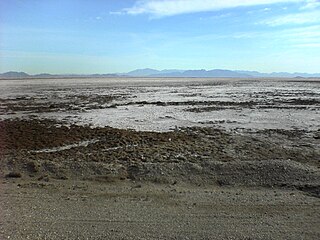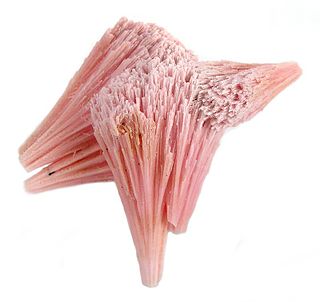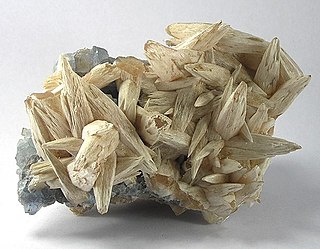
Strontianite (SrCO3) is an important raw material for the extraction of strontium. It is a rare carbonate mineral and one of only a few strontium minerals. It is a member of the aragonite group.

The mineral bastnäsite (or bastnaesite) is one of a family of three carbonate-fluoride minerals, which includes bastnäsite-(Ce) with a formula of (Ce, La)CO3F, bastnäsite-(La) with a formula of (La, Ce)CO3F, and bastnäsite-(Y) with a formula of (Y, Ce)CO3F. Some of the bastnäsites contain OH− instead of F− and receive the name of hydroxylbastnasite. Most bastnäsite is bastnäsite-(Ce), and cerium is by far the most common of the rare earths in this class of minerals. Bastnäsite and the phosphate mineral monazite are the two largest sources of cerium and other rare-earth elements.
Lansfordite is a hydrated magnesium carbonate mineral with composition: MgCO3·5H2O. Landsfordite was discovered in 1888 in a coal mine in Lansford, Pennsylvania. It crystallizes in the monoclinic system (space group P21/c) and typically occurs as colorless to white prismatic crystals and stalactitic masses. It is a soft mineral, Mohs hardness of 2.5, with a low specific gravity of 1.7. It is transparent to translucent with refractive indices of 1.46 to 1.51. The mineral will effloresce at room temperature, producing nesquehonite.

Hydrozincite, also known as zinc bloom or marionite, is a white carbonate mineral consisting of Zn5(CO3)2(OH)6. It is usually found in massive rather than crystalline form.

Vaterite is a mineral, a polymorph of calcium carbonate (CaCO3). It was named after the German mineralogist Heinrich Vater. It is also known as mu-calcium carbonate (μ-CaCO3). Vaterite belongs to the hexagonal crystal system, whereas calcite is trigonal and aragonite is orthorhombic.

Searles Lake is an endorheic dry lake in the Searles Valley of the Mojave Desert, in northwestern San Bernardino County, California. The lake in the past was also called Slate Range Lake and Borax Lake.

Hanksite is a sulfate mineral, distinguished as one of only a handful that contain both carbonate and sulfate ions (a sulfate carbonate). It has the chemical formula Na22K(SO4)9(CO3)2Cl.

Gaylussite is a carbonate mineral, a hydrated sodium calcium carbonate, formula Na2Ca(CO3)2·5H2O. It occurs as translucent, vitreous white to grey to yellow monoclinic prismatic crystals. It is an unstable mineral which dehydrates in dry air and decomposes in water.

Zabuyelite is the natural mineral form of lithium carbonate, with a formula Li2CO3. It was discovered in 1987 at Lake Zabuye, Tibet, after which it is named. It forms colorless vitreous monoclinic crystals.

Bristol Lake is a dry lake in the Mojave Desert of San Bernardino County, California, 42 km (26 mi) northeast of Twentynine Palms.

Nyerereite is a very rare sodium calcium carbonate mineral with formula Na2Ca(CO3)2. It forms colorless, platey pseudohexagonal orthorhombic crystals that are typically twinned. It has a specific gravity of 2.54 and indices of refraction of nα=1.511, nβ=1.533 and nγ=1.535. Nyerereite is not stable in contact with the atmosphere and rapidly breaks down. Collection specimens must be kept in a sealed argon environment.

Tincalconite is a hydrous sodium borate mineral closely related to borax, and is a secondary mineral that forms as a dehydration product of borax. Its formula is Na2B4O7·5H2O or Na2[B4O5(OH)4]·3H2O.

Kutnohorite is a rare calcium manganese carbonate mineral with magnesium and iron that is a member of the dolomite group. It forms a series with dolomite, and with ankerite. The end member formula is CaMn2+(CO3)2, but Mg2+ and Fe2+ commonly substitute for Mn2+, with the manganese content varying from 38% to 84%, so the formula Ca(Mn2+,Mg,Fe2+)(CO3)2 better represents the species. It was named by Professor Bukowsky in 1901 after the type locality of Kutná Hora, Bohemia, in the Czech Republic. It was originally spelt "kutnahorite" but "kutnohorite" is the current IMA-approved spelling.

Ikaite is the mineral name for the hexahydrate of calcium carbonate, CaCO3·6H2O. Ikaite tends to form very steep or spiky pyramidal crystals, often radially arranged, of varied sizes from thumbnail size aggregates to gigantic salient spurs. It is only found in a metastable state and decomposes rapidly by losing most of its water content once removed from near-freezing water. This "melting mineral" is more commonly known through its pseudomorphs.

Nahcolite is a soft, colourless or white carbonate mineral with the composition of sodium bicarbonate (NaHCO3) also called thermokalite. It crystallizes in the monoclinic system.

Searlesite is a sodium borosilicate mineral, with the chemical formula NaBSi2O5(OH)2. It was discovered in 1914 at Searles Lake, California, and was named to honor John W. Searles (16 November 1828 – 7 October 1897), California pioneer, who drilled the well that yielded the first known Searlesite.

Fougèrite is a relatively recently described naturally occurring green rust mineral. It is the archetype of the fougèrite group in the larger hydrotalcite supergroup of naturally occurring layered double hydroxides. The structure is based on brucite-like layers containing Fe2+ and Fe3+ cations, O2− and OH− anions, with loosely bound [CO3]2− groups and H2O molecules between the layers. Fougèrite crystallizes in trigonal system. The ideal formula for fougèrite is [Fe2+4Fe3+2(OH)12][CO3]·3H2O. Higher degrees of oxidation produce the other members of the fougèrite group, namely trébeurdenite, [Fe2+2Fe3+4O2(OH)10][CO3]·3H2O and mössbauerite, [Fe3+6O4(OH)8][CO3]·3H2O.

Kampfite is a rare barium silicate–carbonate–halide mineral with the chemical formula Ba12(Si11Al5)O31(CO3)8Cl5. Discovered in 1964 and described in 2001, it is named after Anthony R. Kampf. The mineral is known only from Fresno County, California.
Clearcreekite is a carbonate mineral, polymorphous with peterbaylissite. The chemical formula of clearcreekite is Hg(1+)3CO3(OH)∙2H2O. It has a pale greenish yellow color and streak with tabular subhedral crystals and good cleavage on {001}. It is transparent with vitreous luster and uneven fracture. Its density (calculated from the idealized formula) is 6.96 g/cm3. The mineral is monoclinic with the space group P2/c. Clearcreekite is an extremely rare mineral from the Clear Creek mercury mine, New Idria district, San Benito County, California. It was probably formed after the alteration of other mercury minerals such as cinnabar. The mineral is named after the locality where it was found.

Benstonite is a mineral with formula Ba6Ca6Mg(CO3)13. Discovered in 1954, the mineral was described in 1961 and named after Orlando J. Benston (1901–1966).


















